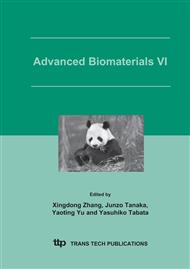p.147
p.151
p.155
p.159
p.163
p.167
p.171
p.175
p.179
A Study on PELGE Nanoparticles as Controlled Drug Delivery Systems for Intravenous
Abstract:
The objective of this study was to evaluate the in vivo characteristics of poly (ethylene glycol)-poly (lacticacid-co-glycolicacid)-poly (ethylene- glycol) (PELGE) copolymers as drug carriers. In order to test this circulation time, mitoxantrone (DHAQ) was used as a model drug in this study. DHAQ nanoparticles (DHAQ-NP) were prepared, subsequently the DHAQ-NP were evaluated by measuring the drug concentration in plasma after intravenous administration via the tail vein of mice. The circulation time of the DHAQ-NP were tested. The results showed prolonged mitoxantrone (DHAQ) residence in systemic blood circulation.
Info:
Periodical:
Pages:
163-166
Citation:
Online since:
June 2005
Authors:
Keywords:
Price:
Сopyright:
© 2005 Trans Tech Publications Ltd. All Rights Reserved
Share:
Citation:


